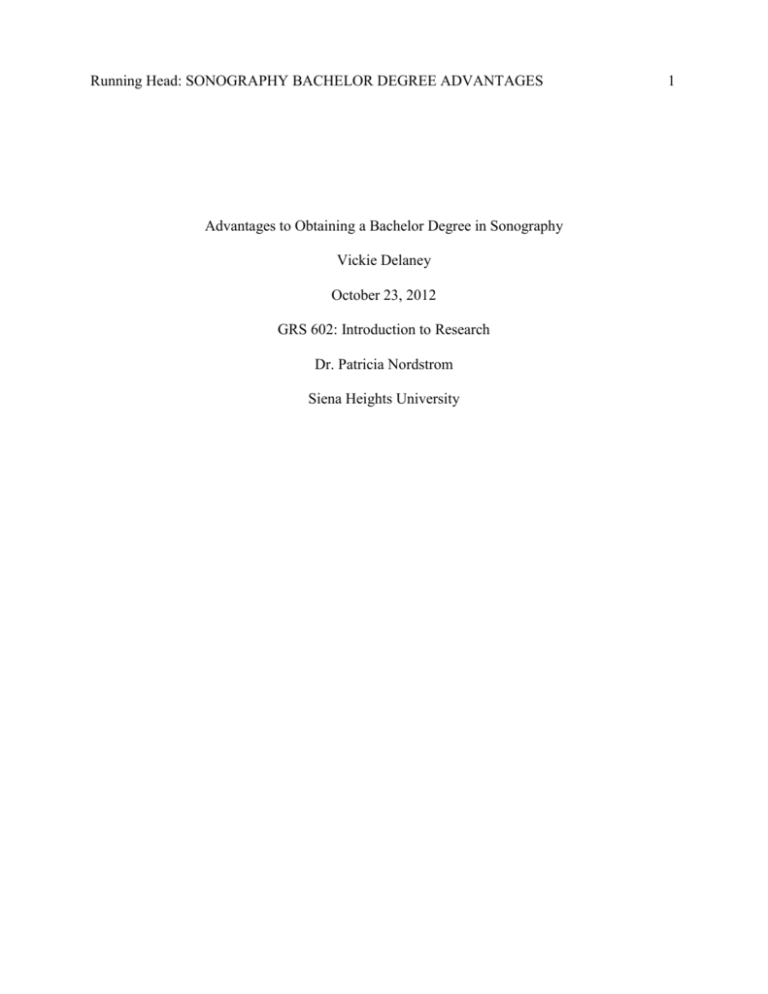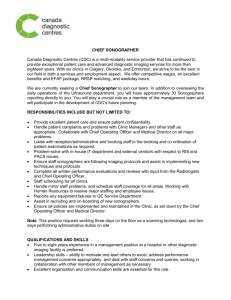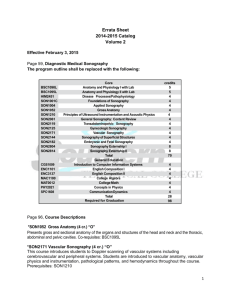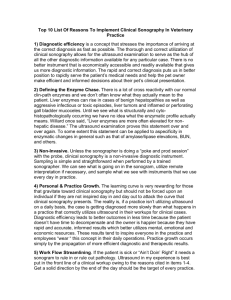Advantages of a Bachelor`s Degree in Sonography
advertisement

Running Head: SONOGRAPHY BACHELOR DEGREE ADVANTAGES Advantages to Obtaining a Bachelor Degree in Sonography Vickie Delaney October 23, 2012 GRS 602: Introduction to Research Dr. Patricia Nordstrom Siena Heights University 1 SONOGRAPHY BACHELOR DEGREE ADVANTAGES 2 Abstract In today’s competitive business world having a higher educational degree is important. The sonographer career ladder, until recently, has not been established. A review of the salary and benefits of sonographers shows a wide variance depending on level of education, training and experience. The advantages for obtaining and the means to complete a baccalaureate degree in Diagnostic Medical Sonography are limited. Keywords: sonographer, career, education SONOGRAPHY BACHELOR DEGREE ADVANTAGES 3 Advantages to Obtaining a Bachelor Degree in Sonography Diagnostic Medical Sonography has been in existence since the mid 1950’s. With the advent of real time, two dimensional imaging the use of ultrasound became widespread for diagnosing pathological states. Over the years training in ultrasound technology has also gone through changes. Today, professional societies, such as the Society for Diagnostic Medical Sonography have introduced criteria for standards of training. These societies have partnered with college accrediting organizations to outline standards and guidelines for entry-level sonographer education and training. The majority of schools offer a certificate or associate degree (CAAHEP, 2012). What is the career path for sonographers beyond entry-level? Are there benefits to obtaining an advanced degree? A Brief History of Sonography Looking at the history of ultrasound, one sees that it was used for detecting enemy submarines during World War I when Paul Langevin was put in charge of developing a technique that came to be called “sonar”. The idea of high velocity sound was further developed by Floyd Firestone. He used it to detect flaws in metal and this technique was adopted for use in medicine (Feigenbaum, 2005). The 1950’s brought with it many new technologies and many advancements in technology. In 1957 the first “pan-scanner” was developed (fig. 1). It employed a tub of fluid and a transducer that moved around the patient. Ultrasound use in medicine continued to move forward until finally in the late 1960’s instruments were created that allowed a recording of the anatomy (Woo, 2002). Initially, images were generated on x-ray type film or photosensitive paper that would develop when exposed to a light source. Only the well trained could decipher those early images (Fig. 2). With new technology, it has become much easier to see many features (Fig. 3). SONOGRAPHY BACHELOR DEGREE ADVANTAGES Fig. 1 Original pan-scanner ultrasound machine, 1957. From www.ob-ultrasound.net. Fig. 2 Very early cardiac ultrasound image. From www.jultrasoundmed.org . 4 SONOGRAPHY BACHELOR DEGREE ADVANTAGES 5 Fig. 3 Fetal ultrasound image . From www.medicexchange.com. Education and Credentialing of Sonographers While the American Medical Association recognized the profession as “ultrasonography” in 1974, there was still the question of, “Who will perform the test?” In the beginning physicians performed exams, but in the early 1970’s radiologists were involved in completing and interpreting the study. In the late 1970’s into the 1980’s and even 1990’s nurses or other medical professionals were taught by a physician or through on the job training by another sonographer. During the 1980’s the increase in the number of tests being done prompted colleges and technology institutes to start developing educational programs in Diagnostic Medical Sonography. Hospitals also offered programs in ultrasonography. How was the curriculum initially developed? Working with the Joint Review Committee on Education in Diagnostic Medical Sonography (JRC-DMS), and the American College of Cardiology, American College of Radiology, American College of Obstetricians and Gynecologists, American Institute of Ultrasound in Medicine, American Society of Echocardiography, American Society of Radiologic Technologists, Society of Diagnostic SONOGRAPHY BACHELOR DEGREE ADVANTAGES 6 Medical Sonography, Society for Vascular Surgery, and Society for Vascular Ultrasound the American Medical Association adopted the first “standards and guidelines” for education in ultrasonography in 1979 (CAAHEP,2011). The Commission for the Accreditation of Allied Health Education Programs (CAAHEP) was incorporated in 1994 in response to the ever growing number of allied health programs and took over this role from the AMA (CAAHEP, 2011). Today schools offering sonography programs attempt to gain accreditation through CAAHEP. This level of accreditation shows that the program has met minimum standards. These standards and guidelines undergo periodic revisions to reflect the changes in the profession. The chart below shows the number of schools offering accredited programs in sonography. This information was obtained from the CAAHEP website. Diploma Certificate Associate Baccalaureate Masters 15 85 113 30 2 The chart shows that most programs offer an associate level degree. Almost half of surveyed sonographers hold an associate degree (SDMS). There are only thirty bachelor level degree programs accredited by CAAHEP and approximately 30% of sonographers surveyed hold this degree (SDMS). In most of the United States sonographers are not licensed but they do have the option of a credentialing exam. Many employers will not consider a potential candidate that does not possess a credential. There are three agencies offering these exams: The American Registry of Diagnostic Medical Sonographers, the American Registry of Radiologic Technologists and (for SONOGRAPHY BACHELOR DEGREE ADVANTAGES 7 cardiac and vascular sonography only) Cardiovascular Credentialing International. These exams are for the entry-level technologist and reflect that level of training and education. Salary and Benefits In 2008 the Society for Diagnostic Medical Sonography sent a salary and benefit survey to their members. The chart below summarizes some of the findings (SDMS). Compensation Employment Median Income $66,768 As an employee 94% Demographics Practice Setting Female 87% Hospital 52% Job Job security satisfaction Work related: Strong strong Private office Career path: 19% weak Clinic 16% Note that sonographers feel their career path is weak. Only 10% were very satisfied with their career paths, almost 40% were neutral on the topic but 16% were dissatisfied and 6% were very dissatisfied. Though median income is at a comfortable level, this survey leads one to believe that sonographers do not feel there is a career pathway. Personal experience has shown that unless you obtain a higher degree, at least a baccalaureate, that advancement to leadership or management roles will not occur. Table number 1, below, shows the differences in salary based on education. There is little evidence, based on these numbers, that those sonographers with a higher degree can expect a larger salary unless you hold a masters or doctorate level degree (SDMS). SONOGRAPHY BACHELOR DEGREE ADVANTAGES 8 Table 1 Total Income by Education $19,999 or less $20,000-29,999 $30,000-39,999 $40,000-49,999 $50,000-64,999 $65,000-79,999 $80,000-99,999 Over $100,000 High School/ GED 21% 5.4% 1.4% 4.0% 7.7% 27.5% 25.8% 15.8% 12.3% Associates Bachelors Masters Doctorate 44.8% 6.0% 3.0% 5.5% 11.6% 24.1% 20.4% 17.9% 11.6% 29.7% 4.1% 3.4% 4.1% 7.7% 26.4% 27.2% 15.4% 11.8% 3.7% 3.2% 3.2% 3.2% 11.3% 11.3% 29.0% 24.2% 14.5% 0.7% 0% 0% 0% 27.3% 0% 18.2% 0% 54.5% Table number 2, below. shows income levels by job title. Managers and Department Directors earn a higher income than staff sonographers or sonographers holding just a supervisory position. Table 2 Regular Income by Job Title $19,999 or less $20,000-29,999 $30,000-39,999 $40,000-49,999 $50,000-64,999 $65,000-79,999 $80,000-99,999 Over $100,000 Sonographer Lead Sonographer 69.2% 4.2% 3.6% 7.6% 17.1% 36.1% 20.1% 6.8% 4.4% 24.2% 1.5% 0.5% 2.2% 5.2% 32.3% 33.5% 18.1% 6.7% Manager or Dept.Dir 4.7% 3.8% 0% 0% 1.3% 14.1% 25.6% 32.1% 23.1% Other 1.9% 3.1% 0% 6.3% 9.4% 21.9% 40.6% 15.6% 3.1% According to the Bureau of Labor Statistics, for medical and health services managers the median income in 2010 is $84, 270 per year and the entry-level education is a Bachelor’s degree with a Master’s degree preferred (Bureau of Labor Statistics, 2012). Career Advancement In 2009, the American Society of Echocardiography proposed the Advanced Cardiovascular Sonographer pathway (Mitchell et al, 2009). CAAHEP has now recognized this SONOGRAPHY BACHELOR DEGREE ADVANTAGES 9 designation and recently posted to its website, “The Standards and Guidelines…were approved by the CAAHEP Board of Directors at its September 21, 2012 meeting. These Standards are from one of the newest professions in which CAAHEP accredits programs and take effect October 1, 2012” (CAAHEP). This pathway recognizes that senior cardiac sonographers can practice at an advanced level and can assist physicians in initial diagnosis and can aid entry-level sonographers in completing a full diagnostic ultrasound exam based on the pathology present. The guideline states that a sonographer should hold a minimum of a Bachelor degree to be admitted to this program. The Standard states that graduates will obtain, at a minimum, a baccalaureate degree and a cardiac or vascular sonography credential. This is one pathway that sonographers now can choose, though currently, there are no accredited programs. Another pathway is that of the Advance Practice Sonographer. This is a title that Society for Diagnostic Medical Sonographers will convey on a technologist. According to the SDMS website sonographers must meet the following criteria to be eligible: ARDMS or CCI certification in each specialty area of APS clinical practice Five (5) years of clinical experience in the specialty area(s) that you are applying for APS status after date of becoming ARDMS or CCI registered in that specialty. Minimum of Bachelor’s degree in Diagnostic Medical Sonography, Echocardiography or Vascular Technology An article published or accepted for publication in a peer-reviewed journal. Coauthorship of article is acceptable. Fifteen (15) hours of specialty specific Continuing Medical Education (CME) credit in the previous three (3) years (for each APS specialty). This requirement SONOGRAPHY BACHELOR DEGREE ADVANTAGES 10 is not in addition to or associated with the ARDMS or CCI continuing education requirements. Note that there is not a credentialing exam or certification that is applied for. The SDMS Salary and Benefit Survey was last completed in 2008 and did not include questions relating to this designation nor the Advanced Cardiovascular Sonographer. The Bureau of Labor Statistics also does not make mention of these new classifications. The current trend in hospitals and larger private practices is to promote only those with more advanced degrees. From the Occupational Outlook Handbook, “Most medical and health services managers have at least a bachelor’s degree before entering the field; however, master’s degrees also are common. Requirements vary by facility” and also “For those already in a different healthcare occupation, a master's degree in health services administration or a related field might be required to advance. For example, nursing service administrators usually are supervisory registered nurses with administrative experience and graduate degrees in nursing or health administration” (Bureau of Labor Statistics, 2012). Higher Education If you are a sonographer that holds an associate’s degree and you desire to further your education and continue to be employed full time the obvious choice is distance education. There is one accredited program offering a bachelor’s degree in sonography via distance education. There are no accredited master’s degrees. Numerous colleges and universities offer healthcare administration degrees and many of these are offered on-line. Referring back to the Occupational Outlook Handbook, it stated that healthcare services managers might need a master’s degree in administration. SONOGRAPHY BACHELOR DEGREE ADVANTAGES 11 Conclusion The healthcare field employment outlook is very good with growth being twice that of other occupations (Damp, 2006). The “baby boomer” generation is aging and people are living longer and this is helping to create the need for more medical professionals (Damp, 2006). So choosing sonography as a profession is a wise decision but at what level of education? Though the field of sonography has been recognized in healthcare since 1974 and by Bureau of Labor Statistics as an independent profession in 2002, there has only recently been a defined career ladder that included education, training and experience. To advance to senior hospital management roles requires a master’s degree. Salary and benefits remain fairly consistent at the bottom and middle rungs of this “career ladder”. More time is needed; more survey information needs to be collected to be able to decide if a bachelor level degree is beneficial to the entry level sonographer. Those sonographers wishing to move to senior management positions will need to pursue not only a bachelor degree but also a master degree in healthcare administration. SONOGRAPHY BACHELOR DEGREE ADVANTAGES 12 References Bureau of Labor Statistics, U.S. Department of Labor (2012). Occupational Outlook Handbook. New York: McGraw Hill. Damp, D. (2006). Health Care Job Explosion!: High Growth Health Care Careers and Job Locator (4th ed.). Moon Township, PA: Bookhaven Press, LLC Ehler, D., Carney, D.K., Dempsey, A.L., Rigling, R., Kraft, C., Witt, S…Waggoner, A.(2001). Guidelines for cardiac sonographer education: recommendations of the American Society of Echocardiography Training and Education Committee. Journal of the American Society of Echocardiography, 14, 77-84. Feigenbaum, H. (2005). History of echocardiography. In H. Feigenbaum, A.F. Armstrong, T. Ryan (Eds.), Feigenbaum’s Echocardiography (6th ed.) (pp.1-9). Philadelphia, PA: Lippincott Williams and Wilkins. McLaughlin, S.M. (2002). Government recognizes sonography occupation. Journal of Diagnostic Medical Sonographers. 18, 112. doi 10.1177/875647930201800213 Mitchell , C., Miller, F., Bierig, M., Bremer, M., Ehler, D., Hanlon, T., …Umland, M. (2009). Advanced Cardiovascular Sonographer: A Proposal of the American Society of Echocardiography Advance Practice Sonographer Task Force. Journal of the American Society of Echocardiography,10,1409-1413. doi:10.1016/j.echo.2009.10.002. SDMS (2008, May 30). Sonographer salary and benefits survey report. Retrieved from http://www.sdms.org/members/salary.asp. Troy, S., Digiacinto, D., Elledge, B. (2004). Advancement of higher education in sonography: Is distance education the answer? Journal of Diagnostic Medical Sonography, 20, 102-111. [Untitled ultrasound image]. Retrieved from http://www.jultrasoundmed.org/content/23/1/1.full. [Untitled fetal ultrasound image]. Retrieved from SONOGRAPHY BACHELOR DEGREE ADVANTAGES http://www.medicexchange.com/news/2010/06/a-study-about-3d-4d-ultrasound/ Woo, J. (2002). A short history of the development of ultrasound in obstetrics and gynecology. Retrieved from http://www.ob-ultrasound.net/history1.html. 13








